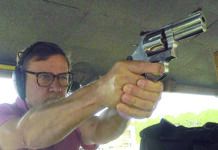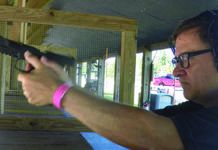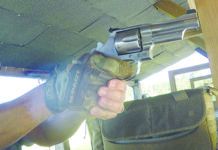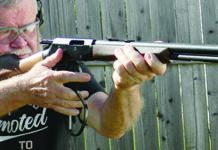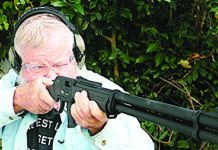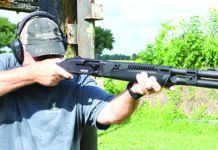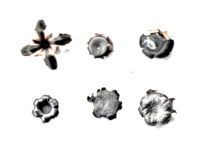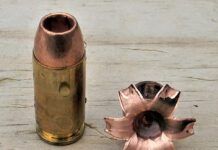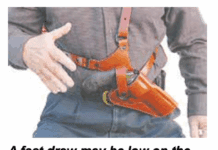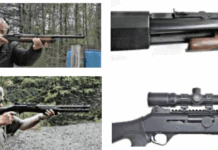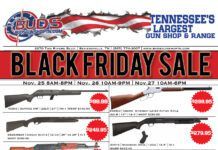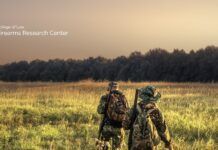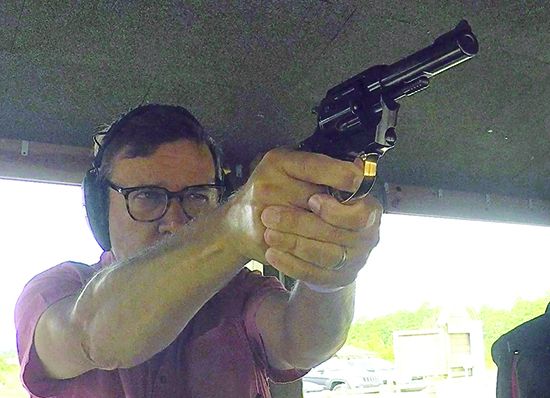When the FBI carried 357 Magnum revolvers between 1981 and 1991, the standard issue was a S&W Model 13 with a medium-sized round-grip K-frame and a 3-inch barrel. Consider the Model 13 a benchmark for a concealed-carry 357 Magnum revolver. It offers better shootability than a smaller-frame revolver with a smaller grip, yet doesn’t feel like a brick on your hip when you carry it.
Medium-frame revolvers are exactly what they sound like. They are an in-between frame that is larger and heavier than a small-frame revolver, yet smaller and less weighty than a large-frame revolver. The extra weight makes medium-frame revolvers easier to shoot well and offers better help with recoil management, while still allowing the revolver to be concealed more easily. You could argue that medium-frame revolvers are just right for concealed carry, offering the hand-filling performance of a large-frame revolver yet sitting in a holster lightly enough to carry all day.
In this vein, we opted to review three medium-frame 357 Magnum revolvers and chose the following: a Colt Python Classic PYTHON-SP2WCTS 357 Magnum, $1317; a Henry Firearms Big Boy Revolver H017BDM, $722; and a Smith & Wesson Model 686 Plus 164300, $896.
We also wanted to see what velocity/energy we would gain or lose with revolvers equipped with a 4-inch, 3-inch, and 2.5-inch barrel. A 3-inch barrel is the benchmark for optimal performance in a medium-size 357 Magnum, according to the FBI.
Even though the three revolvers were new, we checked the cylinder-to-frame headspace and barrel-and-chamber alignment. As suspected, both were in spec. The cylinder-gap spec can indicate whether a revolver will spit out debris that can be felt on your hands. The normal cylinder-gap range is 0.004-0.007 of an inch, measured with a feeler gauge. The Henry had a gap of 0.005 inch, the Colt measured 0.004 inch, and the S&W was a very tight 0.002 inch. We assumed we would not have any problems with splash with these revolvers, and we didn’t. We did note that the S&W may need to be maintained more often if the shooter uses only lead bullets, which may build up deposits on the cylinder face and gum up the works due to the 0.002-inch gap. Here is what we found after the shooting was done.
Henry Firearms Big Boy Revolver H017BDM 357 Magnum
$722
Gun Tests grade: A-
The Big Boy Revolver is nice retro-style wheelgun. The sights are small, and the birdshead grip is circa late 1870s. The double-action trigger pull was smooth, and the single-action pull was okay. The removable cylinder makes the revolver easier to clean, our shooters said.
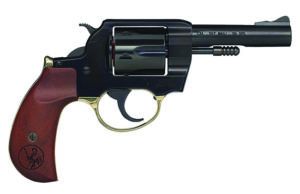
| Action Type | DA/SA |
|---|---|
| Overall Length | 9.0 in. |
| Barrel Length | 4.0 in. |
| Barrel Rifling Twist Rate | 1:16 in. |
| Sight Radius | 5.7 in. |
| Overall Height | 5.2 in. |
| Maximum Width | 1.5 in. |
| Weight Unloaded | 34.0 oz. |
| Weight Loaded | 36.8 oz. |
| Cylinder Gap | 0.005 in. |
| Capacity | 6 |
| Frame | Blued steel/polished brass |
| Barrel | Blued steel |
| Cylinder | Blued steel |
| Frame Front Strap Height | 2.7 in. |
| Frame Back Strap Height | 3.8 in. |
| Grip | Smooth walnut |
| Grip Thickness (Maximum) | 1.2 in. |
| Grip Circumference (Maximum) | 4.6 in. |
| Front Sight | Ramp, screwed |
| Rear Sight | Fixed notch |
| Trigger Pull Weight (Double Action) | 11.0 lbs. |
| Trigger Pull Weight (Single Action) | 6.1 lbs. |
| Trigger Span (Double Action) | 3.6 in. |
| Trigger Span (Single Action) | 2.8 in. |
| Safety | Transfer bar |
| Warranty | Limited lifetime |
| Telephone | (201) 858-4400 |
| Website | HenryUSA.com |
| Made In | U.S. |
Henry is known for lever-action rifles in rimfire and centerfire calibers, as well as single-shot shotguns. A revolver is new and different from this brand, which is solidly planted in traditionally-styled firearms. The Henry Big Boy Revolver, introduced in 2023, is definitely in that time-honored frame of mind. We’d call the Big Boy Revolver old fashioned, but that wouldn’t be doing it justice, since Henry has designed an old-time revolver with modern enhancements like three sizes of front sight blades, transfer bar safety, and easily removed cylinder. Two grip styles are available: the larger, square Gunfighter grip and the rounded, compact birdshead-style grip. We tested the birdshead-grip variant.
Our first impression of the Henry Big Boy Birdshead grip was that it had nice balance and felt like a retro-style revolver such as the Colt M1877, colloquially called the Lightning, which was Colt’s first double-action revolver. The Big Boy grip frame is polished brass, a finish feature found on many of Henry’s rifles and shotguns. Smooth wood grip panels etched with the Henry logo were fitted nicely to the frame. In hand, the Birdshead grip feels small yet fills your hand. It also allows for a high grip on the revolver for double-action shooting.
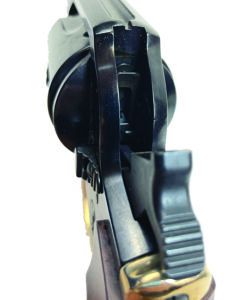
The Henry features a double-action /single-action trigger and six-round swing-out cylinder. The left grip panel is scooped out to use a speed loader. The right side of the frame houses the side plate, similar to S&W, Taurus, and Rossi revolvers. The cylinder rotates counter clockwise and locks up tight. There was hardly any wiggle in the cylinder. The crane locked up into the frame similar to a Ruger LCR revolver. Push the cylinder-release button forward to swing out the cylinder for loading and unloading. The ejector is large, grooved, and rounded at the end, so ejecting empties was positive and easily accomplished without stabbing the palm of your hand. A small button on the inside of the trigger guard is pressed to remove the cylinder assembly from the frame. This makes cleaning the Big Boy easier than a traditional double-action/single-action revolver. The ejector rod is exposed similar to how Colt manufactured many of its double-action/single-action revolvers though the 1950s. The logic behind an exposed ejector rod is that it’s easier to remove debris between the barrel and ejector rod, so there’s less chance of the ejector rod binding and not allowing the cylinder to rotate. It also helps support the retro look of the Big Boy.
Milled out of the top strap is a groove rear sight that offers a channel for the front ramp sight. Henry includes three ramped front sights of different heights — low, medium, and high — so the front sight can be adjusted to your cartridge. In the old days, the front sight was filed down to adjust elevation. A screw holds the front sight in place. The sights are small and thin at best. We would have preferred a thicker front sight and wider rear groove.
During live fire, the birdshead grip curled in the hand when shooting the Magtech 38 Special. The best five-shot group measured 2.5 inches; average was 2.6 inches. Recoil was more noticeable with hotter 357 Mag ammo. The Winchester PDX1 had a best group that measured 2.7 inches, and Federal Hydra-Shoks gave a best group of 2.9 inches. Coincidentally, both the Winchester and Federal had average groups that measured 3.1 inches. The single-action trigger pull was heavy at 6.1 pounds and the sights were smaller, which we contribute to the generally poorer accuracy at 25 yards. At time the recoil from 357 Mag ammo jammed the rear of the trigger guard into our knuckle. There were no reliability issues. Cases ejected smoothly, and the cylinder latch was easy to operate.
The Henry redeemed itself on the 7-yard targets and its smooth double-action trigger pull. We found it easy to control the Big Boy, which offered a high grasp with the rear of the hammer spur just touching the web of our hands in speed shooting.
With two of the three ammos, the Henry’s 4-inch barrel didn’t offer an increase in muzzle velocity over the 3-inch and 2.5-inch-barreled revolvers.
Our Team Said: The Big Boy, especially with the birdshead grip, is a nice period-style double-action/single-action six-shooter. The double-action trigger pull was smooth, and the single-action pull was heavy. The 4-inch barrel had a slight edge in muzzle velocity with only one ammo. The removable cylinder makes the revolver easier to clean. If you want a nostalgic-looking revolver that offers modern safety features, the Big Boy with the birdshead grip is great option.
| 38 SPECIAL AND 357 MAGNUM RANGE DATA | |||
|---|---|---|---|
| 38 Special Magtech 158-grain LRN 38A | Colt Python Classic | Henry Big Boy Revolver | S&W Model 686 Plus |
| Average Velocity | 772 fps | 785 fps | 780 fps |
| Muzzle Energy | 209 ft.-lbs. | 216 ft.-lbs. | 214 ft.-lbs. |
| Smallest Group | 2.67 in. | 2.57 in. | 1.83 in. |
| Average Group | 3.15 in. | 2.64 in. | 2.57 in. |
| 357 Magnum Winchester PDX1 125-grain BJHP | Colt Python Classic | Henry Big Boy Revolver | S&W Model 686 Plus |
| Average Velocity | 1129 fps | 1128 fps | 1126 fps |
| Muzzle Energy | 506 ft.-lbs. | 353 ft.-lbs. | 352 ft.-lbs. |
| Smallest Group | 2.26 in. | 2.79 in. | 2.49 in. |
| Average Group | 2.94 in. | 3.19 in. | 3.05 in. |
| 357 Magnum Federal Hydra-Shok 158-grain JHP P357HS1 | Colt Python Classic | Henry Big Boy Revolver | S&W Model 686 Plus |
| Average Velocity | 1200 fps | 1203 fps | 1214 fps |
| Muzzle Energy | 506 ft.-lbs. | 509 ft.-lbs. | 517 ft.-lbs. |
| Smallest Group | 1.92 in. | 2.94 in. | 1.51 in. |
| Average Group | 1.95 in. | 3.13 in. | 2.03 in. |
To collect accuracy data, we fired five-shot groups from a bench using a rest. Distance: 25 yards with open sights, firing single action. Velocities and energies were recorded using a Garmin Zero C1 Pro chronograph. LRN = lead round nose. BJHP = Bonded Jacketed Hollow Point. JHP = jacketed hollow point.
Written and photographed by Robert Sadowski, using evaluations from Gun Tests Team members. GT




